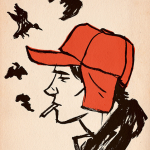While abstract art is far from part of the landscape of popular culture, it nonetheless shares significant attributes with much of the music, television, and film we often experience. Just as abstract art can be confusing and alienating, many of use felt alienated and confused by There Will be Blood or the ending of No Country for Old Men. Just ask the skill required to produce abstract art is either hidden or nonexistent, we have had similar doubts about rock and rap music. Just as abstract art is often based on eastern religions and subjective views of truth, popular culture comes from a similar place.
While these are significant similarities, probably the most striking similarity is that both abstract art and popular culture major on emotional impact rather than intellectual impact. With that in mind, I offer the following live-blog of a lecture by Dr. Steve Halla, assistant professor of Philosophy and Director of the Center for Christianity and the Arts at the Southern Baptist Theological Seminary: Reflections on the Nature and Value of Abstract Art.
These will be reflections, not a formal lecture. It is a chance to think out loud with an audience. I am still working my way through this subject. I want to offer an insight into some of the ideas I’ve been thinking through about this subject.
Why did I choose this topic?
An official reason: There was An exhibition at Sojourn church by Kaori Ishitani, and they asked me to speak on this subject.
2 personal reasons:
First, I am a woodcut artist and so I am a highly representational artist but I am fascinated with Franz Kline and find myself drawn to his work. I am constantly asking myself, why am I continually drawn to his work when much of his work is so similar?
Second, I have been interested in the relationship between Protestantism and Abstract Art. Protestantism has typically maintained a negative or view of abstract art
There are three areas in which Protestants are hesitant to embrace abstract art:
1. Artistic grounds (“anyone can do it” – skill)
(Barnett Newman – Eve vrs. Michelangelo – Pieta) – While Newman’s Eve may be accomplished by almost anyone, Michelangelo’s piece could never be accurately reproduced.
(Ellsworth Kelly, Red, Yellow, Blue – The intelligence behind it: What are the colors that all other paintings ultimately boil down to? RYB)
I still struggle with pieces like this
2. Philosophical Grounds (“I disagree with that” – eg Buddhism, Existentialism, Nihilism)
Because much abstract art has been influenced by various non-Christian worldviews and religions, a negative association has resulted.
3. Church Historical Grounds (Historically the church saw representational art as the only true art)
But we still have to ask why? Where does the valuing of representational over abstract art come from?
We need to establish some basic definitions
Representational Art: “Works of art that closely resemble forms in the natural world. Art in which recognizable objects, figures, or elements in nature are depicted. Art in which it is the artist’s intention to present again or represent a particular subject.”
- “Blanket term for art that represents some aspect of reality in a more or less straightforward way.”
- Art that portrays specific, recognizable physical objects (or objects that are visibly true to life)
- The subject matter is inherent in the artwork (objective)
- Speaks to the viewer’s intellect (mind)
Abstract Art:
- Oxford dictionary of art: “Art that does not depict recognizable scenes or objects, but is instead made up of forms and colours that exist for their own expressive sake.”
- Today, abstract art typically refers to 20th century painting and sculpture (abstract expressionism)
- Subject matter: inherent in the viewer – whatever meaning is derived will come from within
- Speaks to the viewer’s emotions (heart)
Dr. Halla breaks for questions:
Student Asks: “Couldn’t abstract art sometimes represent things, but not in a representative way?”
There are actually 3 forms of abstract art:
1. The kind that starts with actual objects in nature (like a tree, etc.) and simplifies it down to something like a couple lines.
2. The kind that starts with an idea in your mind, and works that out on the canvas
3. Action painting: Like Pollock, you open yourself up to the work, make expressionary motions and it’s over. Pollock wouldn’t be able to tell you what the meaning was, but would say it was just an expression.
So yes, some are representational of things, but ultimately the viewer will have to work out what it actually represents which is something different
Student Asks: “What would detailed fantasy art be described as? Abstract or representational?”
The form would be representational but the ideas may be abstract. The abstract ideas are put forth in a representational way.
Student Asks: What if the objects are representational but the meaning is more abstract (i.e. Van Gogh starry night)
If there is no actual or historical basis of the painting, then the subject matter would still be inherent in the viewer.
It would be put in the representational category, though it does get a bit fuzzy with expressionism and impressionism. With Van Gogh the viewer can at least make out that it is a portrait of someone or a starry night, or whatever the picture may be of.
With Pollock, it always depended on who you read about Pollock. Some said it was pure expression with no foundational ideas while others said he was painting based on Native American spirituality.
Protestantism and Representational Art
Protestants put an emphasis on the didactic function of art (art as an aid in communicating biblical truths and ideas)
1. Emphasize theological clarity/artistic clarity (art as illustration)
Martin Luther said, “It is to be sure better to paint pictures on walls of how God created the world, how Noah built the ark, and whatever other good stories there may be, than to paint shameless worldly things. Yes, would to God that I could persuade the rich and the mighty that they would permit the whole Bible to be painted on houses, on the inside and outside, so that all can see it. That would be a Christian work.”
“And what harm would there be if someone were to illustrate the important stories of the entire bible in their proper order for a small book which might become known as a Layman’s Bible. Indeed, one cannot bring God’s words and deeds too often to the attention of the common man.”
The attention of the common man is aroused by illustrations and examples more readily than by profound disputations.
“I prefer a painted picture over a well written book”
Typical Protestant painting clarifies the difference between the two views. There is no mistaking the message.
Calvin, though had a different idea: You should only visually depict what the eye can physically see.
“we believe it wrong… If it is not right to represent God by a physical likeness… only those things are to be sculpted or painted which the eye can see.”
“even if the use of images contained nothing evil, it still has no value for teaching.”
To depict things in front of us is fine, but to depict the glory of God is wrong, because we can’t see that.
Calvin’s Key Principle: the best art “follows nature”
William A. Dyrness: “If artists followed the order that God has instituted in nature, then he or she would discover the essentially ‘spiritual’ character of art”
The Puritans argue that visual images have a role to play, but not independent of the word
Emphasis: illustration
These were the ideas I had in my mind when I entered the University of Texas to pursue the arts.
2 things happened to me that challenged my perspective of abstract art
Merton and Reinhardt
Merton was for many years the subject of my dissertation
Thomas Merton – had a deep interest in the arts (representational and abstract)
- American-Catholic author, social activist, Catholic Monk
- Father: Owen H. G. Merton, famous painter
- Example of his father’s painting: a second-hand shop, Paris, 1910
Ad Reinhardt
- American painter (1913-1967)
- In 1953 he began limiting his palette to dark hues
- Nearly all of his painting followed the same format. They looked virtually identical in appearance. Dark cross on black background.
- “I’m merely making the last painting which anyone can make.”
- Influences: Zen budhissm, eastern religions, Christianity, etc.)
Merton became acquainted with Reinhardt through Columbia university’s humor magazine and became friends and confidants.
A Parting of ways: Merton went on to monasticism – Reinhardt remained a painter.
Fifteen years later: Merton asks Reinhardt in a later: have you some small black and blue cross painting (say about a foot and a half high) for the cell in which I perch? – He is asking for a small copy of one of his famous paintings specifically to use as an icon for prayer in his cell.
Reinhardt sends it to him after some delay.
Merton cherished the painting: “You have to look hard to see the cross. One must turn away from everything else and concentrate on the picture, as though peering through a window into the night. The picture demands this or is meaningless, for I presume that someone might be unmoved by any such demand. I should say a very holy picture helps prayer. An image without features to accustom the mind at once to the night of prayer, and to help one set aside trivial and useless images that wonder into prayer and spoil it.”
He liked the fact that it had nothing else around it to distract and that you had to ignore everything else to see anything in it.
Learning about this caused me to consider the idea of abstract art and prayer. Is there a role for abstract art in ones prayer life?
Woodcarving
I became interested in woodcarving and studied the nature of woodcut and and woodcarving. I studied different types of wood and noticed that when you studied representational things on a microscopic level, you began to see myriads of abstractions.
I went back to abstract works of art and noticed a similarity (not that such a similarity was intended). I saw that there was abstraction all around us in nature.
The Value of Abstract Art
1. Representational art is an exercise of the intellect
2. Abstract art is an exercise of the imagination
Result: aesthetic enjoyment – I often simply enjoy the pleasure of abstract art.
Viewing abstract art also usually ends up with a moment of Self-reflection
For example: I was viewing an abstract piece named New York by Franz Kline:
As I was viewing it I thought of buildings, then bridges, then the chaoticness of my subway experience, but then about the people I came on the trip with. Then I started thinking about conversations I had with them, and began to praise and thank God for those people and conversations and to pray for them.
This piece of art served as a sort of springboard for my prayer life.
In our spiritual growth and development we can actively use both representational art and abstract art.
But can abstract art play a role in the church? I know it plays a role in my personal life, but I’m still working through the bigger questions.
Dr. Halla makes a fascinating case for the possible value in abstract art. Whether it’s abstract art, film, music, or any other form of painting, we Christians are often too anxious to denounce or decry it simply because we don’t “get it.” The challenge for us is to embrace those things which are good in a piece of art while not embracing the sinful and ungodly. Most impressive is not simply Halla’s challenge to embrace abstract art but to incorporate it into our prayer life. While this seems odd at first, we do have to come to terms with how we will glorify God in every area of our lives. This doesn’t change when we walk into a museum, movie theater, concert or book store.
Every good and perfect gift comes from God. We know that abstract art isn’t perfect, but that doesn’t mean it’s not good.











